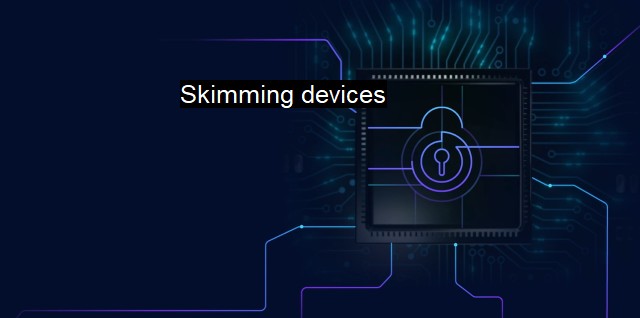What are Skimming devices?
The Menace of Skimming Devices: A Wake-Up Call for Payment Security
Skimming devices can be a significant threat to personal data security. These devices are sophisticated tools used by criminals or hackers to steal credit-or debit-card data. They are typically ingenuously mounted onto existing-point-of-sale (POS) or ATM systems and are designed to blend into the machine, making them hard to detect with the naked eye. The aim is to have an unsuspected victim swipe their card through the skimming device, which then stores the card's data that cybercriminals later retrieve.Skimming devices function by reading the magnetic strip on a card when it's swiped or inserted. The encoded data includes the cardholder's full name, card number, and even the expiry date. Some advanced skimming devices may also contain a hidden camera or keypad overlay to capture the card's PIN. The gathered data can then be used to create counterfeit cards, make unauthorized purchases or to sell the information on the dark web. With the rapid growth of the Internet of Things (IoT), skimming has become more menacing as criminals target self-service kiosks like ticket machines and self-checkouts.
From a cybersecurity perspective, the use of skimming devices represents a major challenge. They typically involve physical interference which is unluckily not efficiently addressed by traditional cybersecurity measures that typically focus on digital threats. While antivirus software plays a vital role in protecting systems and data from digital threats, they can do little against the physical interception of data made possible by skimming devices.
For businesses, defending against skimming devices can be difficult. These devices are becoming increasingly sophisticated, often specifically-designed to evade physical detection. Comparatively smaller alterations at the hardware level, like better peripheral device hardening, and stricter access controls can assist but such approaches are usually reactive and therefore not ultimately sufficient.
Cybersecurity can still play an influential role in mitigating the threat of skimming. With the standardization of encryption, such as the transition to chip-enabled card readers, the number and impact of successful skimming attacks can be significantly reduced. These cards make the task of copying card details far more complex by utilizing an embedded microchip rather than a magnetic strip to store personal data. The microchips create unique, one-time codes for every transaction, making the data worthless to potential thieves.
There are proactive steps that both businesses and consumers can take to protect themselves. By integrating antivirus software with cybersecurity solutions, businesses can more effectively monitor and block the digital communication channels used by data thieves to retrieve skimmed data. Such networks are often used by hackers to retrieve stolen data and this is where antivirus software can flag and block known threats.
Education and awareness are also essential in combatting skimming devices. Consumers should regularly monitor their bank accounts for unauthorized transactions and immediately report anything suspicious. Businesses and banking institutions can raise awareness by educating their customers about the look and characteristics of skimming devices. bank consumers can make use of identity protection services that monitor the use of your card and immediately alert you if anything unusual occurs.
Skimming devices pose a serious threat to the security of personal data and the lack of physical control makes antivirus software largely ineffective in battling this menace. While point of sale systems remains vulnerable until manufacturers can create foolproof scanning and encryption, businesses can minimize risk by making use of advanced cybersecurity tools and strategies such as strong network protections and encryption, along with customer education. Despite the increasing sophistication of these devices, with vigilance, strong cybersecurity infrastructure, and public awareness, the fight against skimming devices can still be won.

Skimming devices FAQs
What are skimming devices in the context of cybersecurity?
Skimming devices are physical devices or hardware tools that are designed to steal credit card or ATM card information from unsuspecting victims. These devices are often placed on ATMs, gas pumps, or other point-of-sale terminals to capture the cardholder's sensitive data.How do skimming devices work?
Skimming devices work by collecting the cardholder's card information through a small device attached to an ATM or other point-of-sale terminal. The device can be either placed on the card slot, the keypad or a similar area of the machine. The skimming device captures the cardholder's card number and PIN as they enter it into the machine, which is then used by cybercriminals for fraud and identity theft.Can skimming devices be detected by antivirus software?
Antivirus software is designed to detect and protect against malicious software and cyber-attacks. However, skimming devices are physical hardware that cannot be identified by antivirus software. To protect against skimming devices, consumers should visually inspect ATMs and other payment terminals for unusual devices or tampering.How can I protect myself from skimming devices?
To protect yourself from skimming devices, always use ATMs and payment terminals in well-lit and high-traffic areas. Look for signs of tampering, such as broken seals or unusual devices attached to the machine. Additionally, cover the keypad when entering your PIN, use chip-enabled cards when possible, and monitor your account for any unusual activity.| | A | | | B | | | C | | | D | | | E | | | F | | | G | | | H | | | I | | | J | | | K | | | L | | | M | |
| | N | | | O | | | P | | | Q | | | R | | | S | | | T | | | U | | | V | | | W | | | X | | | Y | | | Z | |
| | 1 | | | 2 | | | 3 | | | 4 | | | 7 | | | 8 | | |||||||